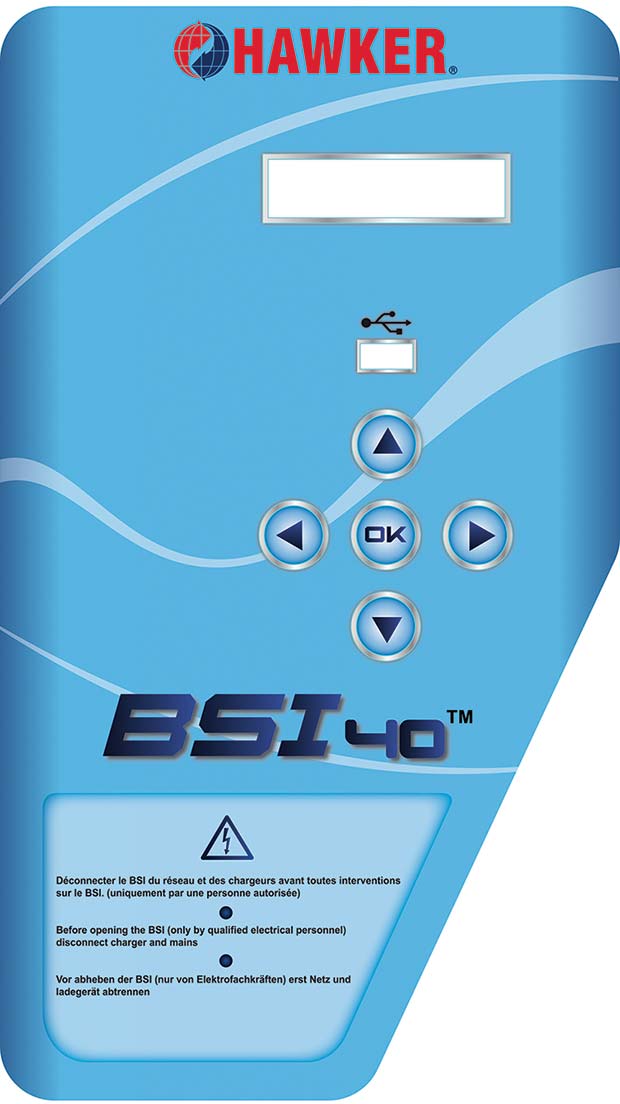The new Hawker® BSI40™ battery status indicator is the latest battery rotation system from EnerSys®. It provides users with a cost-effective solution to manage battery fleets for warehouse trucks and other mechanical handling equipment. The system enables life-long service reliability, efficiency and sustainability. It has been designed for use with the Hawker® Lifetech® HF range of high frequency chargers and can also be integrated with existing chargers by the addition of optional sensors.
 The BSI40 panel is suitable for wall or rack-mounting and can manage up to 40 chargers. Four panels can be networked which means a maximum of 160 chargers can be supported by a single system – more than enough capacity for most fleet users. The batteries can be configured in up to ten separate groups or families. In this way the BSI40 system can manage chargers and batteries with different specifications to provide operators with a high degree of flexibility, adaptability and scalability.
The BSI40 panel is suitable for wall or rack-mounting and can manage up to 40 chargers. Four panels can be networked which means a maximum of 160 chargers can be supported by a single system – more than enough capacity for most fleet users. The batteries can be configured in up to ten separate groups or families. In this way the BSI40 system can manage chargers and batteries with different specifications to provide operators with a high degree of flexibility, adaptability and scalability.
The product is suitable for new and retro-fit installations which enables operators to introduce higher levels of control over existing battery and charger infrastructure with minimal investment. In doing so it offers a straightforward and affordable route into advanced battery fleet management.
The BSI40 battery status indicator is ideal for enforcing first in, first out battery rotation to promote balanced and optimised fleet utilisation. Proper rotation and charge balancing helps to ensure longer truck run-times between changes and maximises battery performance and service life.
Selecting the best battery is also vital to maximising truck fleet up-time and improving profitability.
Simple instructions are issued via an LCD panel on the front of the unit and a larger stand-alone scrolling message display that can be located at any convenient position in the charging area. Both displays indicate clearly to the operator the best available battery to use at the next change. For more robust enforcement, an optional alarm facility can be added to warn when the wrong battery has been selected.
The product communicates with each connected charger to collect and record accurate battery status data including the time and date of charges, changes and alarms. The information can then be transferred by USB memory stick to any PC running the system’s analytical and reporting software.
This software analyses and provides a range of management information to help users understand the demands on the battery fleet. Reports are generated in easy-to-understand graphical views showing battery status and performance.
A battery availability graph, for example, shows the minimum and maximum number of fully charged batteries for each day, which can be useful when fleet planning for peak periods. A report on the number of battery changes made each day helps operators identify performance trends and when capacity is close to maximum. An alarm report provides information on unexpected events such as premature disconnections.
Monitoring battery performance in this way is fundamental to ensuring high levels of battery powered equipment availability to support demanding 24/7 multi-shift applications in warehousing, retail and manufacturing. Optimising battery provision and performance can help to reduce operating costs and streamlines battery changing operations.
Although the BSI40 battery status indicator can work with most types of battery chargers, using it with the Hawker Lifetech HF range of high-frequency chargers can add a further dimension to fleet operations. The Lifetech range offers efficiency levels of over 90 per cent and charging factors of 1.08 to 1.15 depending on the battery technology. These efficiencies can produce reductions in energy consumption of more than 15 per cent compared with conventional 50Hz charger technology which means a lower carbon footprint and significant financial savings.
Correctly specified and installed, the chargers are matched to the batteries and automatically detect the level of discharge and supply only the amount of power needed – and no more – to restore full charge. This means less mains power is required and there is reduced risk of the overcharging that can lead to degraded battery performance and premature failures.
EnerSys Motive Power
Karen Smith
Tel: 0161 727 3800
Email: karen.smith@uk.enersys.com




Comments are closed.